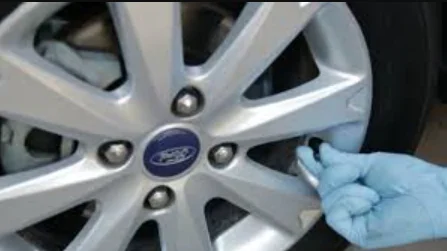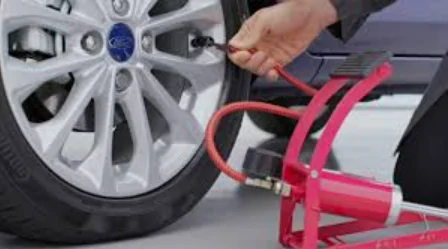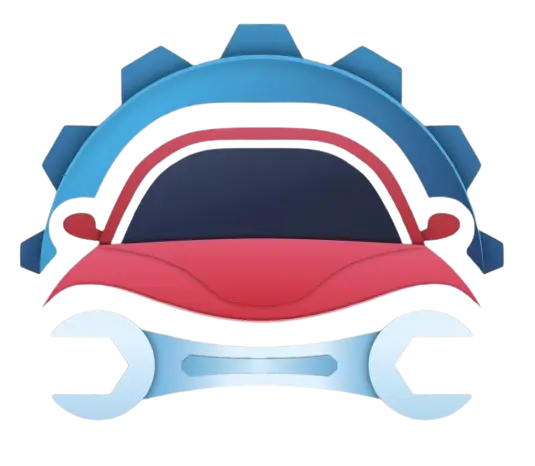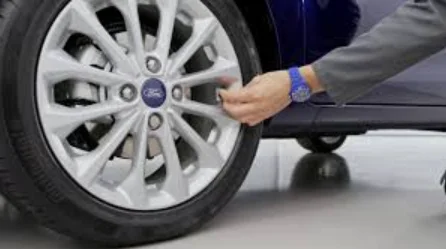Keeping your 2016 Ford Fiesta in peak condition isn’t just about gleaming paint and a purring engine. It’s also about the unsung hero of smooth rides and happy wallets: tyre pressure.
This seemingly simple detail significantly impacts everything from fuel efficiency and handling to safety and tyre longevity. So, buckle up as we guide you through the ultimate guide to mastering your Fiesta’s tyre pressure!
Why Does Tyre Pressure Matter?
Think of underinflated tyres as carrying extra weight. They increase rolling resistance, forcing your engine to work harder and guzzle more fuel.

Conversely, overinflated tyres wear unevenly, compromising grip and potentially causing blowouts. Both scenarios impact handling, responsiveness, and your wallet.
Finding the Right Numbers for 2016 Ford Fiesta
Don’t rely on guesswork! Consult your owner’s manual or the sticker inside the driver’s door jamb for the manufacturer’s recommended tyre pressure values. They vary based on engine size, tyre size, and even load weight.
Table
| Engine | Tyre size | Front pressure | Rear pressure | Front loaded pressure | Rear loaded pressure |
| 1 | 195 45 R16 80H | 36 | 26 | 41 | 46 |
| 1 | 195 50 R15 82H | 33 | 26 | 38 | 46 |
| 1 | 195 50 R16 84H | 33 | 26 | 38 | 46 |
| 1 | 195 55 R15 85H | 33 | 26 | 38 | 46 |
| 1 | 205 40 R17 80H | 36 | 26 | 41 | 41 |
| 1.0 EcoBoost | 205 40 R17 84V XL | 39 | 28 | 41 | 36 |
| 1.2 | 175 65 R14 82T | 33 | 26 | 38 | 46 |
| 1.2 | 195 45 R16 80H | 36 | 26 | 38 | 46 |
| 1.2 | 195 50 R15 82T | 33 | 26 | 38 | 46 |
| 1.2 | 195 50 R16 84H | 30 | 26 | 38 | 38 |
| 1.2 | 195 55 R15 85T | 33 | 26 | 38 | 46 |
| 1.2 | 205 40 R17 80H | 36 | 26 | 41 | 41 |
| 1.3 8V | 175 65 R14 82T | 30 | 26 | 36 | 41 |
| 1.3 8V | 195 45 R16 80H | 30 | 29 | 33 | 38 |
| 1.3 8V | 195 50 R15 82H | 29 | 26 | 36 | 41 |
| 1.4 | 195 45 R16 80H | 33 | 26 | 38 | 38 |
| 1.4 | 195 50 R15 82T | 33 | 26 | 38 | 46 |
| 1.4 | 195 50 R16 84H | 33 | 26 | 38 | 46 |
| 1.4 | 195 55 R15 85T | 33 | 26 | 38 | 46 |
| 1.4 | 205 40 R17 80H | 36 | 26 | 41 | 41 |
| 1.4 LPG | 195 50 R16 84T | 30 | 26 | 38 | 46 |
| 1.4 LPG | 195 55 R15 85T | 30 | 26 | 38 | 46 |
| 1.6 16V | 175 65 R14 82H | 30 | 26 | 36 | 41 |
| 1.6 16V | 195 45 R16 80V | 30 | 29 | 33 | 38 |
| 1.6 16V | 195 50 R15 82H | 29 | 26 | 36 | 41 |
| 1.6 ST Turbo | 205 40 R17 84W XL | 36 | 26 | 41 | 41 |
| 1.6 Ti-VCT Sport | 195 45 R16 84V XL | 36 | 26 | 41 | 46 |
| 1.6 Ti-VCT Sport | 205 40 R17 84V XL | 36 | 26 | 41 | 41 |
| 2.0 ST 150 | 195 45 R16 80V | 32 | 29 | 33 | 38 |
| 2.0 ST 150 | 205 40 ZR17 XL | 32 | 29 | 36 | 41 |
Remember to check pressure when tyres are cold (not driven for at least 3 hours) for an accurate reading.
Tools of the Trade
Invest in a good quality tyre pressure gauge and a reliable tyre inflator. Digital gauges provide precise readings, while portable pumps or gas station compressors offer convenient inflation options.
Pumping Up Your Knowledge
Seasonal variations and heavy loads can affect tyre pressure. Expect a slight drop in pressure during colder months and consider slightly increasing it when carrying heavy cargo.

The Consequences of Incorrect Tyre Pressure
Driving with underinflated or overinflated tyres can have adverse effects on your vehicle. Underinflated tyres can lead to increased rolling resistance, reducing fuel efficiency and causing premature wear.
On the other hand, overinflated tyres may compromise traction, resulting in decreased handling and an uncomfortable ride. Regularly checking and maintaining the correct tyre pressure is a simple yet effective way to avoid these issues.
Tips for Regular Tyre Maintenance
- Check Tyre Pressure Monthly: Make it a habit to check your tyre pressure at least once a month, especially before long drives. This can help you catch any potential issues before they escalate.
- Use a Reliable Pressure Gauge: Invest in a good-quality tyre pressure gauge to ensure accurate readings. Many gas stations provide free air, making it convenient for you to check and adjust your tyre pressure as needed.
- Inspect for Wear and Tear: While checking tyre pressure, take the time to inspect the overall condition of your tyres. Look for signs of wear, bulges, or cuts, and address any issues promptly.
- Rotate Tyres Regularly: Rotating your tyres helps distribute wear more evenly, extending their lifespan. Consult your owner’s manual for the recommended rotation intervals.
Warning Signs
Heed the Tyre Pressure Monitoring System (TPMS) warning light! It indicates potential pressure issues.
Check your tyres immediately and adjust as needed. Ignoring a low-pressure warning can lead to accidents and tyre damage.
Maintaining Optimal Performance
Proper tyre pressure translates to
- Improved Fuel Economy: Less rolling resistance equals more miles per gallon.
- Enhanced Handling: Predictable steering and precise cornering.
- Reduced Tyre Wear: Even wear means longer tyre life.
- Increased Safety: Optimal grip minimizes accident risk.
Beyond the Basics
Consider a TPMS tool for constant monitoring and instant alerts. Don’t forget to check your spare tyre pressure!
Conclusion
Mastering your 2016 Fiesta’s tyre pressure isn’t rocket science, but it’s the secret sauce to a smooth, safe, and budget-friendly driving experience.
By prioritizing this simple yet crucial factor, you’re not just caring for your car, you’re investing in your own driving enjoyment and peace of mind.
So, grab your gauge, pump your knowledge, and hit the road with confidence!
FAQs
Q: How often should I check my tyre pressure?
Ideally, check tyre pressure once a month and before long trips.
Q: What happens if I ignore low tyre pressure?
Low pressure can lead to increased fuel consumption, uneven tyre wear, reduced handling, and potentially, blowouts.
Q: Can I over-inflate my tyres for better fuel economy?
No, over-inflation can wear tyres unevenly and compromise handling. Stick to the recommended pressure.
Q: What should I do if my TPMS light comes on?
Check your tyre pressure immediately and adjust as needed. If the light remains on, consult a mechanic.
Q: Do I need different tyre pressure for winter tyres?
Some winter tyres may require slightly different pressure. Check your manual or consult a tyre professional.
Remember: This is just a starting point. Feel free to personalize the content and expand on specific sections to cater to your audience’s needs. Happy driving!

